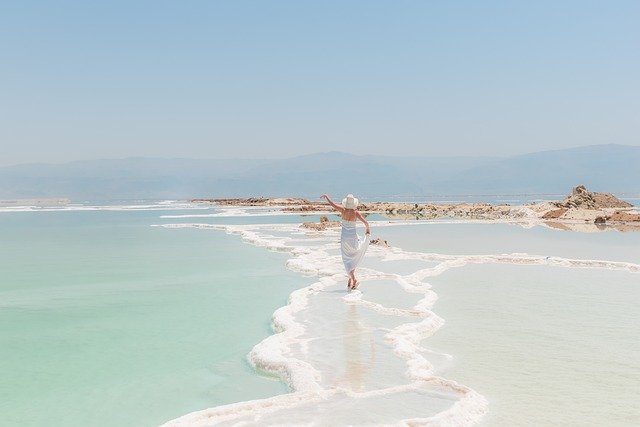
The Dead Sea
“It was a funny bath. We could not sink. One could stretch himself at full length on his back, with his arms on his breast, and all of his body above a line drawn from the corner of his jaw past the middle of his side, the middle of his leg and through his ancle bone, would remain out of water. He could lift his head clear out, if he chose…” – Mark Twain describing swimming in the Dead Sea in 1867.
The Dead Sea is an undrained salt lake between Israel and Jordan.
By its salt concentration the Dead Sea is second only to the Lake Assal in Africa.
Its surface and the coast are at 422 meters below sea level, and this level is constantly decreasing. The Dead Sea lies in the intercontinental depression resulting from the split of Eurasia and Africa.
The Dead Sea is one of the most saline water bodies in the world; its salinity reaches 33.7%. The lake is 67 km long and 18 km at its widest point, the maximum depth of the lake is 378 meters.
The first mention of the name “Dead Sea” is found in the writings of the ancient Greek scholar Pausanias, who was one of the first, explored its waters.
The sea is called “dead” because it was thought that due to its high salt content neither fish nor other organisms could survive living in it.
Surprise! Over 70 species of oomycete fungi were found in the Dead Sea during recent years. These fungi are capable of living in a maximum salinity conditions.
The Dead Sea is fed by several ephemeral streams and the Jordan River.
In the area of the Dead Sea were found the famous Dead Sea Scrolls. These scrolls are also referred to as the Qumran Scrolls.
More than 600 manuscripts that were found in 1947 are proving that the Jewish sect of Essenes, existing in the II century B.C., lived by the rules very similar to the evangelical principles.
The Biblical cities Sodom and Gomorrah were located in the area of the Dead Sea.
The water of the Dead Sea is hardly water, it would be better to say “a strong solution of salt.” The mineralogical composition of the salt of the Dead Sea is significantly different from the composition of the salt of other seas. It contains about 50.8% magnesium chloride, 14.4% calcium chloride, 30.4% sodium chloride and 4.4% of potassium chloride. There is a smaller amount of the sulfates but relatively large amount of bromides in the Dead Sea water.
These conditions allowed the Dead Sea to turn into a unique health resort, created by nature. The resort attracts millions of tourists from all the corners of the world.
In addition to the unique composition of mineral salts, the Dead Sea is also known for its healing mud, which is extracted from the bottom of the lake.
The famous Dead Sea mud is highly mineralized and rich with bromine, iodine and hormone-like substances.
Because of the high concentration of mineral salts and intensive evaporation the whole Dead Sea area smells of sulfur. The temperature here seldom falls below 40° C.
The Dead Sea is a strange and even mystical place. It creates a unique atmosphere. The constant evaporation envelops the whole area in a mysterious haze. It’s very quiet here. Not even a single bird singing is heard in this place.
According to the biblical story, Lot’s wife was turned into a pillar of salt, as a punishment for disobeying orders and looking back at Sodom. (Genesis 19, 17, 26).
On the east side of the salt mountain Sodom there is a round pillar of salt crystal, in the height of 40 feet; With some imagination it may easily seem as a human figure.
A visit to the Dead Sea is an unforgettable experience, but some factors may overshadow the joy of meeting with this wonder of the world.
How to protect yourself at the Dead Sea
- Dangerous Beach: the Dead Sea is constantly receding, leaving a surface coated with a deceptively hard crust. Here lies the death danger. In some places under the crust there is void. In the best case it will be unplanned mud bath, in worst you can simply drown here as in the swamp. If you decided to go for a “wild vacation” be sure to carefully inspect and check the beach surface.
- Protect your eyes! The water in the Dead Sea is extremely caustic. The composition of the minerals is very hurtful for the eyes. Bathe carefully so not to spray the water into your own eyes and into eyes of others. The consequences of the entering Dead Sea water into the eyes can be very unpleasant. If the water still gets in the eyes immediately rinse them with fresh water. Do not rub your eyes!
- You think you cannot drown in the Dead Sea? Wrong! Many believe that the high density of the Dead Sea water prevents from sinking in it. But anything could happen – a cramped leg or heatstroke. People could drown as a consequence of such incidents. Keep close to the beach!
- Mud treatments. The duration of the mud treatments and radon baths should never exceed 10-15 minutes. Longer treatments are harmful for the body.
- At the Dead Sea you should always have an adequate supply of fresh water. Especially in summer time when the temperature exceeds the limit. Drink water to prevent dehydration.
- Rainwater flows. During the rainy season on the shores of the Dead Sea many powerful mudslides from the surrounding hills are formed.
- These flows of mud could be very dangerous for vehicles and people. Watch the weather forecasts and read the road signs carefully, talk to the locals before the trip.
These rules are simple, but important. Follow these rules and your trip to the amazing wonder of nature, the Dead Sea, will be unforgettable in a positive sense of the word.






